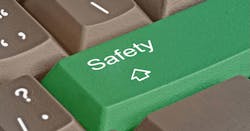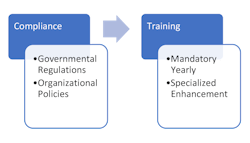While it is essential to have a safety program, it’s critical to transform culture from contentment to involvement. Several factors influence the need for manufacturing organizations to incorporate a safety program within their facilities. Regulations are viewed as primary by many individuals with a mindset of contentment. Individuals that exhibit an involvement mindset understand the impact safety has on the well-being of the workforce.
Requirement: It’s The Law
Workforce safety is mandatory within all organizations. In 1970 the U.S. Congress created the Occupational Safety and Health Administration (OSHA). OSHA is responsible for making certain that safe and healthy working conditions exist in all industries. Accomplishment is achieved by setting standards and ensuring compliance. Government regulations guarantee organizations continue to focus on the reduction and elimination of workplace injuries.
Financial Impact
Another primary factor driving organizations to continue to seek a reduction in injuries is cost. A safety incident incurs a cost of medical care as well as in productivity and the mental health of individuals. Each incident generates a direct financial impact on an organization. After seeing a colleague’s injury in the workplace, the mental state of employees can last throughout their careers and contribute indirectly to significant cost implications to the organization.
Consistent From Year to Year
Manufacturing facilities continue to rank #2 behind healthcare facilities for most injuries. Manufacturing leadership continues to be challenged to seek continuous improvement activities to lower and eliminate concerns across their span of control. The dynamic environment of manufacturing generates a moving potential hazard condition.
A unique set of inputs can increase the level of a hazard condition rating. Understanding these inputs and controlling their state is critical to minimize the safety potential level. This continuous hazard condition cycle requires dedicated audit frequency throughout an organization to prevent injury to the workforce.
Measuring is a critical input requirement for focus improvement efforts. Facilities that isolate responsibility to a couple of individuals view the task as a requirement. Engagements from all levels in the organization are required to achieve a comprehensive assessment and help drive the elimination of hazards.
Characterization of Workplace Injuries
Facilities track injury data based on location and specific occupations. Based on data, risk level development (high, medium, low) occurs for location and occupation. Strategic priorities are centered on high-risk and work-down lists. This methodology makes an assumption that all inputs to factors contributing to risk remain consistent. Research has proven that tracking risk activity programs need to incorporate inputs that can contribute to the risk. These inputs can either increase or decrease the potential level of risk, not only tracking risk activity.
Severity of Risk
Hazards are present throughout any facility. An organization must review all and determine the level of countermeasures required. Determination for actions is based on risk assessment of the hazard. A periodic review of risk levels helps an organization determine if countermeasures remain sufficient to control the hazard condition.
Safety programs are composed of two pillars: compliance and training (Figure 1). They are interlinked and required for a successful safety program. Every organization follows a similar process to track and document compliance with governmental and organization specifics. Training implementation is also handled in a common manner.
Workplace Structure
To manage and control safety injuries, organizations are responsible for abiding by governmental policies and regulations. Governmental standards provide a minimal level of hazard protection for employees. Organizations take localized actions and create additional standards. The local standards supplement governmental regulations with customized standards to support the uniqueness of operations. Localized standards help to align high potential locations or occupations with employee well-being. Additional policies by organizations help solidify the commitment to well-being of the workforce.
Employee Education
Initial and periodic training sessions are held to instruct the employee on standards for compliance. Customization of training with local equipment-specific procedures and pictures directly influences employees’ perception of the organization’s commitment. In addition, it helps employees comprehend policies and regulations. Having a consistent awareness of occupational health and safety helps increase the workforce’s involvement in the mitigation of potential hazards.
Leading by example has been discussed at length within publications. The impact is significant on workforce acceptance and adoption of initiatives.
Shifting to Involvement
To shift safety response from reactive to proactive, a transformation must occur within the workforce from contentment to involvement (Figure 2). To drive culture change within the workforce, the safety leadership team must lead by example. Show sincere expression of concern for abnormal hazards and participation in resolution discussion/implementation, and set the expectations high for other individuals in the work zone.
References
Occupational Safety and Health Administration. Safety and health topics: healthcare. Washington, DC: US Department of Labor, Occupational Safety and Health Administration.
U.S Bureau of Labor Statistics. Industry Injury and Illness Data.
Saso Krstovski, Ph.D., is a lean manufacturing/Six Sigma master black belt at Ford Motor Co., Van Dyke Electric Powertrain Center, and an adjunct professor in the Engineering Department of Lawrence Technological University. He serves on the executive committee for the IEOM Society. He also serves on the board of directors for Michigan Lean Consortium and leads its communities of practice for academia.
Jake Ruchala is a safety engineer for Ford Motor Co. His latest focus has been the utilization of technology to help change the culture around safety. Prior to this, he served as world class manufacturing safety pillar lead with Fiat Chrysler Automobiles (now Stellantis).
About the Author
Saso Krstovski
Saso Krstovski, Ph.D., is a lean manufacturing/Six Sigma master black belt at Ford Motor Co., Van Dyke Electric Powertrain Center, and an adjunct professor in the Engineering Department of Lawrence Technological University. He serves on the executive committee for the IEOM Society. He also serves on the board of directors for Michigan Lean Consortium and leads its communities of practice for academia.
Jake Ruchala
Jake Ruchala is a safety engineer for Ford Motor Co. His latest focus has been the utilization of technology to help change the culture around safety. Prior to this, he served as world class manufacturing safety pillar lead with Fiat Chrysler Automobiles (now Stellantis).


